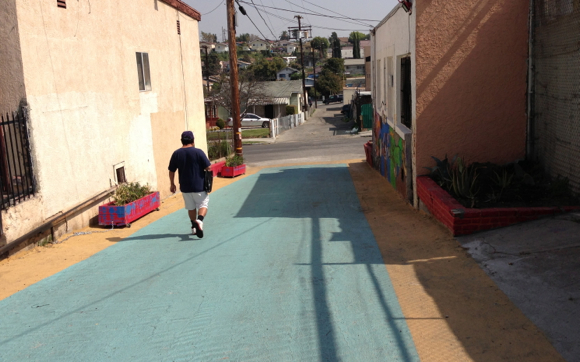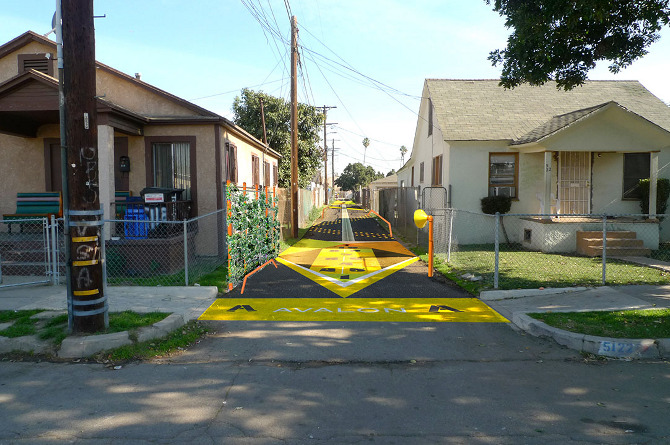
A painted alley two blocks from Soto Street and Whittier Boulevard in Boyle Heights. Image by Kris Fortin/LAStreetsblog
What’s an alley in LA for anyway?
Alleys have been a part of human settlement since humans started settling. Alleys are great places to arrange for trash and waste hauling, deliveries, and connecting up to utilities. Since all these intrinsically messy things happen in alleys, we don’t often think of them as places to hang out, play, or socialize. Alleys nowadays are mostly places with negative connotations due to this history.
Now that we’ve gotten rid of trash collecting trucks hand-hauling miscellaneous trash cans in our alleys, delivery men drop off cardboard boxes and not fresh produce, domestic servants are mostly unheard of, and horse stables aren’t pumping out mountains of waste, alleys in LA have become nether-regions. Sure, we need to give the LADWP and the gas and telephone company access to service their systems, but most of the time alleys are seen as a liability to neighbors. Their negative association with a dirty past allow our alleys to become places where the many vices of humanity can find safe harbor: trash dumping, drug dealing, vandalism, etc.
With much of their historical reason for existing now gone, what new needs can alleys provide for? What is being done with alleys and how is it being done?
Los Angeles is piloting two different approaches to re-thinking alleys: as high-priced water collection areas and as human-oriented shared space.

LA’s Watershed Protection Program collaboration with the Trust for Public Land’s Avalon Green Alley Network rendering. Image by CONTENT OBJECT DESIGN STUDIO
KPCC’s Adrian Florido published an article this morning about an alley near the corner of Avalon Boulevard and 52nd Street in South Central Los Angeles that is being turned into a $2.3 million rainwater filter.
A few years ago, Streetsblog LA was the first to cover a no-budget transformation of an alley in Boyle Heights between Mathews Street and Penrith Drive into a more human-scaled shared space. The story was picked up by Boyle Heights Beat and a really nice video was made to describe what was done.
The rainwater filtering alley has not yet begun construction, but already the warning signs are there that this will be little more than a gold plated green-washing. From the KPCC Report:
“[Wing Tam, a manager in the City of Los Angeles’ Watershed Protection Division] said a key to the pilot project’s success will be getting the people who live along the green alleys to help maintain them, since there’s no money budgeted for upkeep.”
The article continues:
“Building that local support in South L.A. has largely fallen on the Trust for Public Land.
On a recent morning, a bunch of neighbors — mostly women — descended on one of the alleys with brooms, rakes and plastic bags. A group of students from a nearby high school joined them.
This Green Team, as the group is called, started three years ago, as part of the Trust’s effort to build local interest in the alleys.”
Take away the $2.3 million and the Trust for Public Land and what you have is the type of community effort that re-made the alley in Boyle Heights!
Cleaning rainwater is a noble goal, but without community buy-in this $2.3 million project will turn into a mess in 20 or 30 years. Why should we spend so much for a single project? Money doesn’t seem to be the problem when it comes to clean and safe alleys – community support, and neighborly relations, seem to be the real issue.
Imagine how far that $2.3 million could be stretched, how many more alleys could be regularly cleaned, repurposed, and turn into a valuable amenity if the focus was on re-establishing the types of human networks that have been dissolved in the Bowling Alone-era.
Our alleys have lost much of their utility – trash collection and deliveries have been motorized and mechanised; we’re hauling less of the rotting stuff away in carriages while the service people who used to deliver to and clean homes are no longer being employed. This open space behind buildings has turned into a no-mans land. Two different approaches to retrofitting our alleys to serve new needs highlight the one critical component in any change in the city: community buy-in.
What is lacking when it comes to LA’s alleys is neighbors collective action, not money. If saving rainwater is our priority, let’s not make it a gold-plated unmaintainable mess. Community buy-in, neighborhood connections, a living social fabric is where we need to begin.
One Comment
Interesting related article:
https://lacreekfreak.wordpress.com/2010/01/19/places-to-visit-bimini-slough-ecology-park/
About a depaving project that replaced a stretch of street with a bioswale & park in LA’s Koreatown.
One Trackback
[…] Transforming L.A.’s Alleys (Flying Pigeon) […]